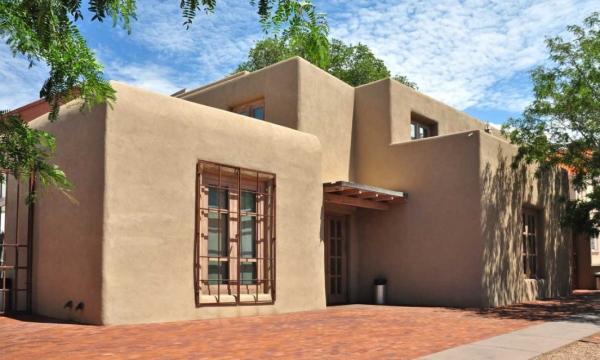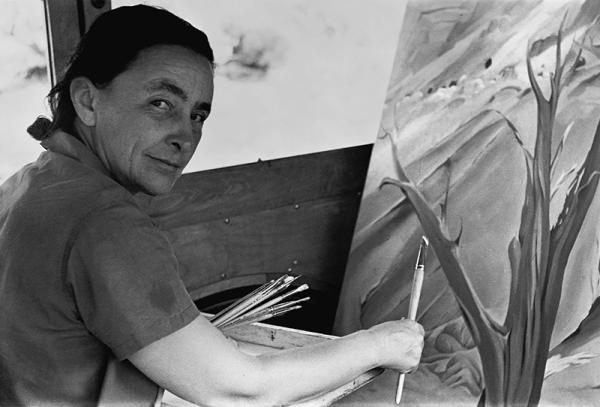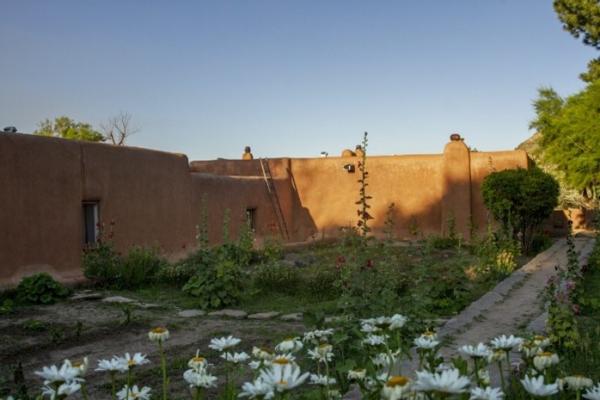A Visionary Museum with a Storied Past: Construction and Preservation at the Georgia O’Keeffe Museum

The current Georgia O’Keeffe Museum in Santa Fe reflects O’Keeffe’s love of Puebloan architecture, and the planned renovation will maintain the same architectural influence.

The current Georgia O’Keeffe Museum in Santa Fe reflects O’Keeffe’s love of Puebloan architecture, and the planned renovation will maintain the same architectural influence.
In many ways, the Georgia O’Keeffe Museum rests at a crossroads. It is located in Santa Fe, New Mexico, a unique borderland region in U.S. history where Indigenous, Mexican, and American history converge. The land that is now Santa Fe is the ancestral homeland of many Indigenous Puebloan groups and beginning in the sixteenth century, the area has at times been a part of the Spanish Empire, Mexico, and the United States. These varied influences have imbued Santa Fe with a unique cultural legacy that reflects its layered past.
The Georgia O’Keeffe Museum also sits at a new kind of intersection as it works to both preserve the historical legacy of the site and adapt for the future. Since 2019, the museum has been planning a multipronged project to construct a new exhibition building, renovate its research center, and upgrade its administration facility. Throughout this project, it seeks to honor the multifaceted history of the land.
During the course of this NEH-supported capital project, Indigenous artifacts were found buried beneath the surface of the proposed site, triggering a careful review process that required the close collaboration of the museum, the city of Santa Fe, tribal leadership, and NEH staff. The Georgia O’Keeffe Museum undertaking highlights how important federal preservation laws are in ensuring that cultural artifacts are handled with care and respect, and how collaboration is the key to success with such projects.
The Georgia O’Keeffe Museum (GOKM)is dedicated to the influential American Modernist painter of the same name, whose desert landscape paintings have become synonymous with the U.S. Southwest. The museum opened in July 1997 and encompasses several locations: the main museum, research center, and library in Santa Fe; the O’Keeffe House Museum in Abiquiú; and the famed Ghost Ranch in northern New Mexico. Today, the combined campuses hold more than 3,000 works by O’Keeffe as well as a collection of her personal artifacts, photographs, and letters, and welcome more than 150,000 visitors every year. In addition to the exhibitions, the museum includes a research center that offer visitors the chance to explore O’Keeffe’s personal life and her enduring legacy in the art world.
The museum’s extensive renovation project will allow it to showcase more of O’Keeffe’s art, and as Renee Lucero, a representative of the Georgia O’Keeffe Museum, put it, “enrich the museum’s storytelling.” The new and updated facilities will have a state-of-the-art climate system, and, in keeping with O’Keeffe’s profound love of nature, the buildings will utilize energy-efficient, sustainable design and locally sourced materials.
Along with the renovation of the existing research center and administrative buildings, the project will also design and construct a brand new, 50,000-square-foot facility that will provide space for the museum to host educational programs to attract a wide array of visitors. Local community engagement is at the core of the GOKM’s mission, and by creating the infrastructure for more public-facing events, the museum hopes to become an integral part of Santa Fe’s cultural landscape.
The museum’s development plans, however, were met with some complications. Santa Fe has zoning laws in its historic districts that are designed to preserve its unique aesthetic. Since the museum fell within the historic district zone, it was subject to those restrictions, including a limit on height. To lower the building’s overall height but maintain the square footage, the museum project team considered adding a basement to the building. However, preliminary excavations for the basement revealed artifacts both from the pre-historic period and from Fort Marcy, a Mexican American War-era site.
These finds classified the area as a ‘prehistoric archeological site,’ which precipitated more regulations before the new construction could begin. The presence of Indigenous artifacts meant that the museum needed to consult with tribes that had historic and cultural connections to the area before any modifications or construction could take place as well. The museum would have to comply with federal-level historic preservation laws and navigate a complex process, ensuring cultural sensitivity for all the layers of history connected to the site.
What is Historic Preservation Law, and what does it have to do with grants?
Section 106 is a key component of the National Historic Preservation Act, which was enacted in 1966 to protect historical and archaeological sites in the United States from unchecked development. This requirement stipulates that all federal projects consider any potential effects on historic properties and culturally significant sites and take measures to avoid, minimize, or mitigate any negative impacts. Since NEH, a federal agency, provided the O’Keeffe Museum with financial support, the project must comply with this regulatory framework.
For the GOKM, adhering to Section 106 ensures that its expansion plans respect and preserve the rich history of the area. The section 106 process is not intended to prevent development; it seeks to find balanced outcomes that honor historical significance while still allowing for progress and adaptation to future needs. Accordingly, all the parties who have a stake in the project have a voice, which meant that in addition to federal guidelines, GOKM needed to work with the city, state, and all tribal governments that were connected to the impacted land.
What are the stages of Section 106?
Once a project has been proposed, the project team must identify and assess the effects of the project on any historic properties that are involved. In this case, the museum worked in partnership with the New Mexican State Historic Preservation Office (SHPO) and a team of archeologists from the state of New Mexico to determine what lay under the ground. Ann Piesen, a grants policy analyst in NEH’s Office of Grant Management, worked closely with the project team, serving as a liaison between the federal, state, and consulting parties involved. Piesen emphasized that great care was taken to maintain clear communication throughout the process and reported that museum staff kept all involved parties abreast of its developments and findings every step of the way. Lucero commented that “while the process was rigorous and lengthy, the museum valued the guidance and expertise of all parties to maintain the highest level of safety and respect for the history of the space.”
The state archeological team conducted a reconnaissance survey of the land, which is a non-invasive examination of the land and subsurface. Their findings revealed artifacts from many time periods: Indigenous ceramics, Spanish colonial objects, animal bone, and items used in the Mexican American War of 1846. State historians, architects, and consultants also considered both the impact on the above-ground environments, ensuring that none of the surrounding historic buildings would be adversely impacted by the construction.
The work involved many parties and took three years to complete. Ultimately, it was determined that the proposed construction had no adverse effect on the surrounding historic properties but did have an adverse impact on the archeological items buried on the site. GOKM worked with NEH, New Mexico’s SHPO, the tribal historic preservation offices, and consulting archeologists to identify ways to mitigate these effects, and in 2024, a Memorandum of Agreement was signed.
The agreement stipulates that the museum must implement the Secretary of the Interior’s Historic Properties Treatment plan, which helps mitigate any negative impacts on the archeological grounds. According to Piesen, displaced soil will be stored on tribal land, and if any Native American human remains are found, the burials will remain on-site in an undisclosed location. This is intended to safeguard the physical artifacts and ensure that any sensitive cultural information of the Indigenous communities is protected as well. Now, as the Georgia O’Keeffe Museum continues to move forward with their expansion, they honor not just the life and legacy of Georgia O’Keeffe, but also the multilayered history that lies beneath the site.
Piesen reported that the working experience with the many partners was positive overall. “Although this was a complicated grant project, NEH is happy and excited about the outcomes. It’s great to see this project start to come to fruition with the completion of the MOA,” she stated. Lucero agreed and expressed appreciation for the input and contribution of their partners at the state, local, and tribal level. “The experience has set a productive precedent for how the museum can be a thoughtful partner in Santa Fe, [and] we hope to share our experience with future NEH grantees and other institutions, especially in New Mexico,” she added. With the agreement in hand, the expansion project can now move forward.
The Georgia O’Keeffe Museum project highlights the importance of historic preservation law for federally funded cultural projects in ensuring that the site’s cultural heritage is preserved. These regulations are especially crucial at sites where Indigenous histories have been whitewashed, erased, or taken out of context. By carefully adhering to these laws and working alongside state and tribal officials, the Georgia O’Keeffe Construction Project stands as a testament to how careful planning, collaboration, and respect for cultural heritage can lead to successful and meaningful development projects.
The Georgia O’Keeffe Museum project was supported by an Infrastructure and Capacity Building Challenge Grants award. This program has been discontinued, but there are several other NEH funding opportunities for your organization to support the preservation of historic and cultural sites of significance:
-Climate Smart Humanities Organizations
-Sustaining Cultural Heritage Collections
-Save America’s Treasures (run in partnership with the National Park Service)



